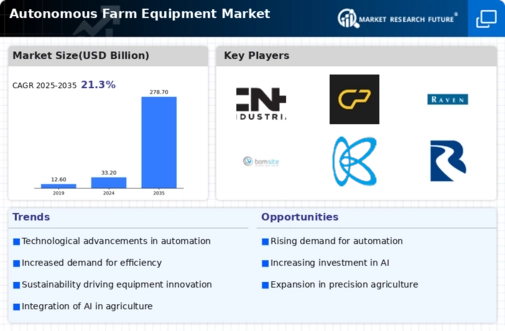Labor Shortages
Labor shortages in the agricultural sector are a pressing issue that the Global Autonomous Farm Equipment Market Industry is addressing. As the workforce in agriculture ages and younger generations show less interest in farming careers, the need for automation becomes increasingly critical. Autonomous farm equipment can mitigate these labor challenges by performing tasks traditionally done by human workers. For example, autonomous harvesters can operate continuously, ensuring timely harvesting and reducing crop loss. This shift towards automation not only addresses labor shortages but also enhances productivity, contributing to the projected compound annual growth rate of 21.34% from 2025 to 2035.
Rising Global Food Demand
The rising global food demand is a significant driver for the Global Autonomous Farm Equipment Market Industry. As the world population continues to grow, the pressure on agricultural systems to produce more food sustainably intensifies. Autonomous farm equipment can help meet this demand by increasing efficiency and productivity in farming operations. For instance, autonomous planting and harvesting technologies can operate around the clock, maximizing output. This increased efficiency is essential in addressing food security challenges, particularly in regions facing resource constraints. The market's growth trajectory, from 33.2 USD Billion in 2024 to 278.7 USD Billion by 2035, reflects the urgent need for innovative solutions to meet global food needs.
Sustainability Initiatives
Sustainability initiatives are becoming a focal point within the Global Autonomous Farm Equipment Market Industry as consumers and governments push for environmentally friendly practices. Autonomous farm equipment can significantly reduce the environmental impact of agriculture by optimizing resource use, minimizing chemical inputs, and enhancing soil health. For instance, precision agriculture technologies enable farmers to apply fertilizers and pesticides more efficiently, reducing runoff and pollution. This alignment with sustainability goals is likely to drive market growth as stakeholders seek solutions that not only improve productivity but also adhere to environmental regulations and consumer preferences.
Technological Advancements
The Global Autonomous Farm Equipment Market Industry is experiencing rapid technological advancements that enhance the efficiency and effectiveness of agricultural practices. Innovations in artificial intelligence, machine learning, and robotics are driving the development of autonomous tractors, drones, and harvesters. These technologies enable farmers to optimize their operations, reduce labor costs, and increase crop yields. For instance, autonomous tractors equipped with GPS and sensors can operate with minimal human intervention, allowing for precision farming. As a result, the market is projected to grow from 33.2 USD Billion in 2024 to 278.7 USD Billion by 2035, indicating a robust demand for advanced farming solutions.
Government Support and Incentives
Government support and incentives play a crucial role in the expansion of the Global Autonomous Farm Equipment Market Industry. Many governments are recognizing the potential of autonomous technologies to enhance food security and agricultural efficiency. As a result, they are implementing policies and providing financial incentives to encourage the adoption of autonomous farm equipment. For example, subsidies for purchasing autonomous machinery or funding for research and development initiatives can significantly lower the barriers to entry for farmers. This supportive regulatory environment is likely to accelerate market growth and facilitate the transition towards more automated agricultural practices.




















